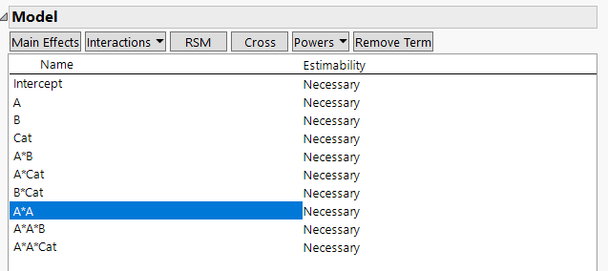- We’re retiring the File Exchange at the end of this year. The JMP Marketplace is now your destination for add-ins and extensions.
- JMP 19 is here! Learn more about the new features.
- Subscribe to RSS Feed
- Mark Topic as New
- Mark Topic as Read
- Float this Topic for Current User
- Bookmark
- Subscribe
- Mute
- Printer Friendly Page
Discussions
Solve problems, and share tips and tricks with other JMP users.- JMP User Community
- :
- Discussions
- :
- Re: Why does the interaction between a squared term and a main effect always cor...
- Mark as New
- Bookmark
- Subscribe
- Mute
- Subscribe to RSS Feed
- Get Direct Link
- Report Inappropriate Content
Why does the interaction between a squared term and a main effect always correlate with the main effect?
I am setting up a custom experimental design with three factors, two continuous and one categorical. I want to look at main effects, one way interactions and a squared term for one of the continuous factors, this is all fairly straightforward. What I also want to look at is the interaction between the main terms and the squared term. To me this means how the level of a given factor affects the form of the curvature described by the squared term.
For the following factors I therefore have the subsequent dialogue in the custom design view.
A: Continuous
B: Continuous
Cat: Categorical, 2 level
However, when I construct the design, no matter how many runs I decide on the correlation map shows very high (~0.8) correlations between:
B and A*A*B
Cat and A*A*Cat
Can anyone help me out as to why this is, whether it's an issue and if there is a workaround. My initial thought is that as A*A will always have a positive sign the sign of A*A*B will always have the same sign as B (and equivalently for A*A*Cat and Cat).
Many thanks,
Dave
- Mark as New
- Bookmark
- Subscribe
- Mute
- Subscribe to RSS Feed
- Get Direct Link
- Report Inappropriate Content
Re: Why does the interaction between a squared term and a main effect always correlate with the main effect?
The correlation between parameter estimates inflates the variance of the estimates (standard errors). This correlation degrades power, but the parameters are still estimable. If the correlation is 1 (confounded effects, aliased terms), then the VIF is infinite, and the parameters are inestimable. So rules of thumb like VIF < 10 are silly in my opinion. It depends on the size of the effect and the variance. A VIF > 10 might be tolerable / acceptable if the variance is low to begin with or the effect is large relative to the variance. On the other hand, a VIF < 10 might be intolerable if the variance is high to begin with or the effect is small. It all depends. The power analysis and estimation efficiency provide information about your particular situation. It all depends.
- Mark as New
- Bookmark
- Subscribe
- Mute
- Subscribe to RSS Feed
- Get Direct Link
- Report Inappropriate Content
Re: Why does the interaction between a squared term and a main effect always correlate with the main effect?
You said, " If Time somehow interacts with the self-interaction of Temp*Temp, it must also interact somehow with Temp on it's own. In this example, you can't physically have Time interact with (Temp*Temp) without also somehow interacting with Temp alone. It wouldn't make sense for Time to interact with the response's curvature with Temp without also interacting with the response's slope with Temp."
Actually, that is mathematically, statistically, and physically possible. I like @statman's explanation. The degree of non-linearity could depend on the level of the categorical factor while the linear response does not. You just have to see what the data and model have to say about it.
- « Previous
-
- 1
- 2
- Next »
Recommended Articles
- © 2025 JMP Statistical Discovery LLC. All Rights Reserved.
- Terms of Use
- Privacy Statement
- Contact Us


